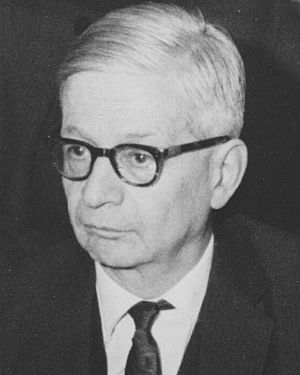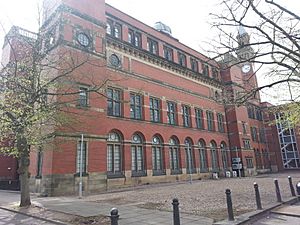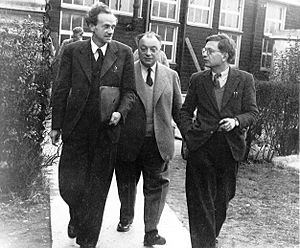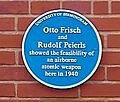Rudolf Peierls facts for kids
Quick facts for kids
Rudolf Peierls
|
|
|---|---|

Rudolf Peierls in 1966
|
|
| Born |
Rudolf Ernst Peierls
5 June 1907 |
| Died | 19 September 1995 (aged 88) Oxford, Oxfordshire, England
|
| Citizenship | German (1907–1940) British (1940–1995) |
| Alma mater | University of Berlin University of Munich University of Leipzig University of Manchester St John's College, Cambridge |
| Known for | Peierls argument Peierls bracket Peierls droplets Peierls substitution Peierls stress Peierls transition Peierls–Bogoliubov inequality Peierls–Nabarro potential Bohr–Peierls–Placzek relation Frisch–Peierls memorandum Charge density wave theory Umklapp process Tube Alloys project |
| Awards | Commander of the Order of the British Empire (1946) Medal of Freedom (1946) Royal Medal (1959) Lorentz Medal (1962) Max Planck Medal (1963) Knight Bachelor (1968) Enrico Fermi Award (1980) Matteucci Medal (1982) Copley Medal (1986) |
| Scientific career | |
| Fields | Physicist |
| Institutions | University of Manchester University of Cambridge University of Birmingham New College, Oxford University of Washington Manhattan project |
| Thesis | Zur kinetischen Theorie der Wärmeleitung in Kristallen (1929) |
| Doctoral advisor | Werner Heisenberg |
| Other academic advisors | Wolfgang Pauli |
| Doctoral students | Fred Hoyle E. E. Salpeter Gerald E. Brown Stuart T. Butler Walter Marshall James S. Langer John Stewart Bell Stanley Mandelstam |
| Other notable students | N. M. Butt M. A. Beg |
Sir Rudolf Ernst Peierls (born June 5, 1907 – died September 19, 1995) was a very important physicist. He was born in Germany but later became a British citizen. He played a key role in the Tube Alloys project, which was Britain's effort to build a nuclear weapon. He also worked on the Manhattan Project, the larger Allied program to create the atomic bomb. Many people remember him as a major figure in the history of nuclear physics.
Contents
Rudolf Peierls: A Brilliant Physicist
Rudolf Peierls studied physics at several famous universities. He learned from great minds like Werner Heisenberg and Wolfgang Pauli. In 1929, he earned his PhD. He then worked as an assistant to Pauli in Switzerland.
In 1932, Peierls received a special scholarship. This allowed him to study in Rome with Enrico Fermi. He also studied at the University of Cambridge in England. Because he was from a Jewish family, he decided not to return to Germany in 1933. This was after Adolf Hitler came to power. Peierls stayed in Britain and continued his important work.
A New Home in Britain
After deciding to stay in Britain, Peierls worked at the University of Manchester. Later, he moved back to Cambridge. In 1937, a professor named Mark Oliphant invited him to the University of Birmingham. There, Peierls became a professor of applied mathematics, which is now called theoretical physics. This job gave him a stable and permanent position.
Peierls worked on many interesting physics problems. He studied how atoms behave in crystals and how electrons move in metals. He also helped explain the idea of "holes" in semiconductors. These are like empty spaces where electrons should be, which helps explain how electricity moves through materials.
The Atomic Bomb Project
In March 1940, Peierls wrote a very important paper with Otto Robert Frisch. This paper, called the Frisch–Peierls memorandum, was the first to explain that an atomic bomb could be made from a small amount of uranium-235. Before this, scientists thought a bomb would need tons of uranium, making it impossible to build.
The paper showed that a bomb could be much smaller and more powerful. This discovery made the British and American governments very interested in nuclear weapons. Peierls also helped recruit another scientist, Klaus Fuchs, to work on the British nuclear project, called Tube Alloys.
Working on the Bomb
As the war continued, the British and American efforts to build the atomic bomb joined together. This became the Manhattan Project. Peierls moved to the United States to work on this secret project. He helped design the special lenses needed to make the bomb work. He was also in charge of a group of scientists working on the bomb's design.
Peierls was present at the first test of an atomic bomb, called the Trinity nuclear test, in July 1945. After the war, he returned to England. He received awards for his work on the project, including the Commander of the Order of the British Empire and the US Medal of Freedom.
Facing Suspicion
Later, in 1950, Klaus Fuchs, whom Peierls had recruited, was found to be a spy for the Soviet Union. Because Peierls had brought Fuchs into the project and was close to him, some people suspected Peierls too. He also had a Russian wife and kept in touch with scientists in the Soviet Union.
However, it was later proven that Peierls was not a spy. The real spies were identified, and Peierls's name was cleared. Despite the suspicion, he continued his important work in physics.
Working for Peace
After the war, Peierls went back to the University of Birmingham. He worked there until 1963. He then became a professor at the University of Oxford until he retired in 1974. He continued to study many areas of physics, including nuclear forces and quantum field theory.
Peierls also wrote several books, explaining complex physics ideas. He was very concerned about the nuclear weapons he had helped create. He worked with groups like the Bulletin of the Atomic Scientists and the Pugwash Conferences on Science and World Affairs. These groups aimed to control nuclear weapons and promote peace.
Peierls's wife, Genia, passed away in 1986. He remained active even as his eyesight worsened. He continued to read scientific papers using a computer screen. Rudolf Peierls died in 1995 at the age of 88.
Awards and Recognition
Rudolf Peierls received many honors for his contributions to science. He was made a knight in 1968, which means he could use the title "Sir."
He also received many prestigious awards, including:
- The Royal Medal in 1959
- The Lorentz Medal in 1962
- The Max Planck Medal in 1963
- The Enrico Fermi Award in 1980
- The Copley Medal in 1986
In 2004, a building at the University of Oxford was named the Sir Rudolf Peierls Centre for Theoretical Physics in his honor. This shows how much his work is still valued in the world of science.
Images for kids





